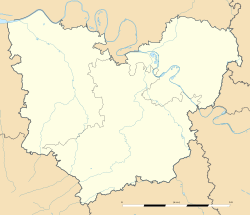Saint-André-de-l'Eure Airport
| Aérodrome de Saint-André-de-l'Eure | ||
|---|---|---|
|
|
||
| Characteristics | ||
| ICAO code | LFFD | |
| Coordinates | ||
| Height above MSL | 150 m (492 ft ) | |
| Transport links | ||
| Distance from the city center | 2 km southwest of Saint-André-de-l'Eure | |
| Street |
D 833 , 7 km N 154 |
|
| Basic data | ||
| opening | 1930s | |
| operator | Commune of Saint-André-de-l'Eure | |
| Runways | ||
| 05R / 23L | 1100 m × 50 m grass | |
| 05L / 23R | 400 m × 40 m grass | |
The Aérodrome de Saint-André-de-l'Eure is an airfield of the General Aviation It lies in the region of Normandy in the department of Eure in the area of Saint-André-de-l'Eure and Les Authieux about fifteen kilometers southwest of Evreux . The airfield was used as a military airfield during the Second World War .
history
The airfield was built in the 1930s as a regional airport in Haute-Normandie, initially without a paved runway.
After the armistice of 1940 it served the German Air Force as a base. At the end of June 1940, the I. Group of Jagdgeschwader 2 (I./JG 2) with their Bf 109E lay here for a few days . During the Battle of Britain from the end of July 1940 to mid-April 1941, Saint-André was stationed for the II. Group of Kampfgeschwader 54 (II./KG 54) equipped with Ju 88A .
The airfield was massively expanded, including paved taxiways, two 1600 m long concrete runways and other permanent buildings. Between July 1941 and April 1942, the resulting air base was used for night raids on England. For this purpose, the II. Group of Kampfgeschwader 55 (II./KG 54) on He 111H and in July / August 1942 the I. Group of Kampfgeschwaders 30 (I./KG 30) were in Saint-André from November 1941 to April 1942 their Ju 88A stationed.
In the war that followed, the airfield served as a base for interceptors against the daytime attacks of the heavy bombers of the Eighth Air Force of the United States Army Air Forces (USAAF). Therefore, from the beginning of December 1942, with an interruption in March / April 1943 to June or October 1943, Fw 190A from staff and I. Group of Schnellkampfgeschwader 10 (S. and I./SKG 10) were stationed here.
After a lengthy repair and expansion phase, it was again used by various air force units in the winter of 1943/1944. In December / January the 1st squadron of Kampfgeschwader 51 (1./KG 51) was here with their Me 410 . From mid-May to early June 1944 the Ju 188A of the I. Group of KG 54 (I./KG 54). At the beginning of the Allied invasion , this had already been replaced by the Ju 88A of the 4th Squadron of Kampfgeschwader 6 (4./KG 6) in its place again for a few days after the start of the invasion III. Gruppe des Jagdgeschwader 3 (III./JG 3), a Bf 109G association, joined. The last Luftwaffe unit stationed here, also equipped with Bf 109G, was the 4th Squadron of Reconnaissance Group 123 (4th (F) / 123) from mid-June to early July 1944 .
In 1943/1944 the airfield was repeatedly the target of American air raids. See also attacks by moderate numbered B-26 bombers and P-47 - fighter-bombers of the Ninth Air Force .
After the area was cleared by the German troops, the damaged airfield was first repaired by American troops and then handed over to the British Royal Air Force . Airfield B.24 , as its allied code name, became the base of the Second Tactical Air Force . From July to September 1944, this was where the 122nd Wing, equipped with Mustang Mk.III , was located . In addition to the RAF, the American 442d Troop Carrier Group also used the airfield with their C-47s between November 1944 and September 1945 . He was then handed over to the French Air Force.
They placed him under their flight test center Center d'Essais en Vol (CEV) in Villacoublay , and the training took place on Nord Martinet , Nord 1100 and SIPA . The CEV left the airfield in 1975.
Todays use
The airfield was completely rebuilt in a smaller form as a civil airfield for general aviation . In addition to the main runway, it has another short grass runway that is only used by microlight aircraft . The Aéro-Club de l'Eure (ACE) was founded in 1957 and renamed Club Aéronautique de Saint André (CASA) in 1960 .
Outside the airfield area used today, there are still a number of relics of the old military airfield, especially to the east.
Web links
- Homepage of the air sports club (French)
- Aeronautical chart for Saint-André-de-l'Eure Airport on SkyVector.com
Individual evidence
- ↑ a b AD 1.3 INDEX OF THE AERODROME. (No longer available online.) In: AIP France. SIA, March 3, 2016, archived from the original on March 5, 2016 ; accessed on March 4, 2016 (French, English). Info: The archive link was inserted automatically and has not yet been checked. Please check the original and archive link according to the instructions and then remove this notice.
